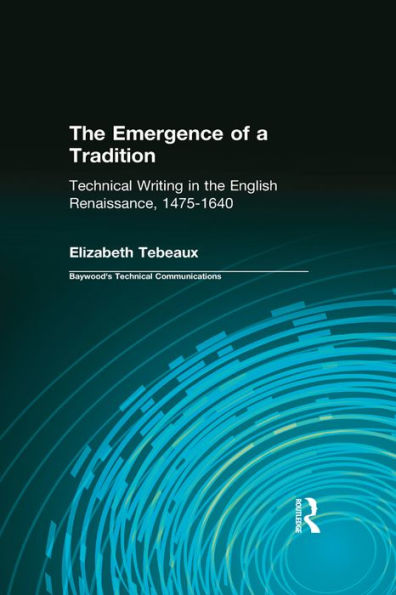
The Emergence of a Tradition: Technical Writing in the English Renaissance, 1475-1640
246
The Emergence of a Tradition: Technical Writing in the English Renaissance, 1475-1640
246eBook
Available on Compatible NOOK devices, the free NOOK App and in My Digital Library.
Related collections and offers
Overview

Product Details
| ISBN-13: | 9781351841269 |
|---|---|
| Publisher: | Taylor & Francis |
| Publication date: | 02/06/2018 |
| Series: | Baywood's Technical Communications |
| Sold by: | Barnes & Noble |
| Format: | eBook |
| Pages: | 246 |
| File size: | 9 MB |
About the Author
Table of Contents
Chapter 1—In Search of Our PastThe purpose of this book is to show that early English technical writing anticipates many of the same issues important to modern technical writing: writers were aware of the comprehension levels of their intended readers; many technical books were designed for ease of use. That is, they exemplified good page design as well as a structure and a style that would enhance the readability and usability of the information. Increasing use of graphics and visual aids to convey information enable modern researchers to track the shift from orality to textuality and from textuality to visual presentation as a means of conveying methods of performing work. English Renaissance technical books show the triumph of textual instruction over oral instruction.
Chapter 2—The Rise of Technical Writing in the English Renaissance
This chapter summarizes historical events that nurtured the growth of technical writing in the English Renaissance: the growth of wealth, the growth of knowledge, the advent of printing, the rise of humanism. The chapter also surveys examples of technical books produced throughout the Renaissance—medical books, books on farming and animal husbandry, books on gardening, books on household management and cooking, books on recreation, books on military science and navigation in addition to a variety of how to books covering technologies important to life in the English Renaissance.
Chapter 3—Format and Page Design in English Renaissance Technical Books: Early Recognition of Reader Context and Literacy Level
This chapter examines a number of technical books published from 1489 to 1640 to show changes in format—emergence of tables of contents, listing, bulleted lists, and use of Ramist dichotomies—bracketed tables, overviews, cause-effect analysis—in logic books, medical books, religious books, and even geography and culinary books.
Chapter 4—Renaissance Technical Books and Their Audiences: Writers Respond to Readers
Examining English Renaissance technical books also shows that their writers were aware of the information needs and the reading comprehension level of their readers. Analyzing the presentation methods used by these early technical writers reveals how they adapted material for these readers' information needs as well as the literacy level of these intended readers.
Chapter 5—English Renaissance Technical Writing and the Emergence of Plain Style: Toward a New Theory of the Development of Modern English Prose
The majority of studies of the rise of modern English have ignored technical books and their pervasive use of plain style. By considering technical books in addition to traditional canonical books considered in language study, we may thus question the view that no plain style of consequence existed prior to Bacon.
Chapter 6—From Orality to Textuality: Technical Description and the Emergence of Visual and Verbal Presentation.
Examining the first printed English technical books allows us to see how printing, the growth of knowledge, and the rise of literacy all worked in tandem. The merging of visual and verbal in technical books allows us to trace the demise of orality as a means of conveying knowledge in many fields.
Chapter 7—The Legacy of English Renaissance Technical Writing: New Perspectives on Basic Rhetorical Issues
This book and its survey of technical writing in the English Renaissance allow modern technical writing teachers and researchers to see that many of our modern concerns evolved during the first century of printing. Examining early forms of technical writing shows that technical writing has a long and honorable history and a tradition that has implications for modern assessments of language and style.
Preface
Tebeaux's approach to her material makes the book necessary reading for all people interested in technical communication, whether they be scholars, teachers, or practitioners. She examines Renaissance how-to books through the lens of the central issues of contemporary technical writing. She shows how these early writers created effective books by using the same principles that contemporary writers use, principles such as audience analysis and adaptation, readability, the plain style, formatting, and visual aids to clarify technical description.
Tebeaux's analysis of the texts' use of these strategies contributes in many ways to our understanding of technical discourse. One of the most intriguing is her discussion of the evolution of modern formatting conventions that helped make texts readable.
Another important contribution to our understanding of the history of technical writing is Tebeaux's analysis of Bacon's contributions to the rise of the plain style.
This is an important book, a classic in the field. While its primary audience will be specialists in technical communication, specialists in other areas ranging from literacy theory, history of publishing, theory of textuality, to Renaissance prose will find it instructive. Furthermore, The Emergence of a Tradition both fills a scholarly void and provides a model for this kind of historical scholarship. As Tebeaux suggests in her conclusion, researchers can apply her methods to studies of other historical periods, cultures, and types of technical communication."
Emergence of a Tradition provides a broad brush picture of technical
communication as it emerged and developed during the English
Renaissance, the first period of printed English books. It examines and
traces the development of a number of procedural books that explained
how to perform tasks important to the daily lives of people in
Renaissance England.
—Written by Michael G. Moran, University of Georgia
